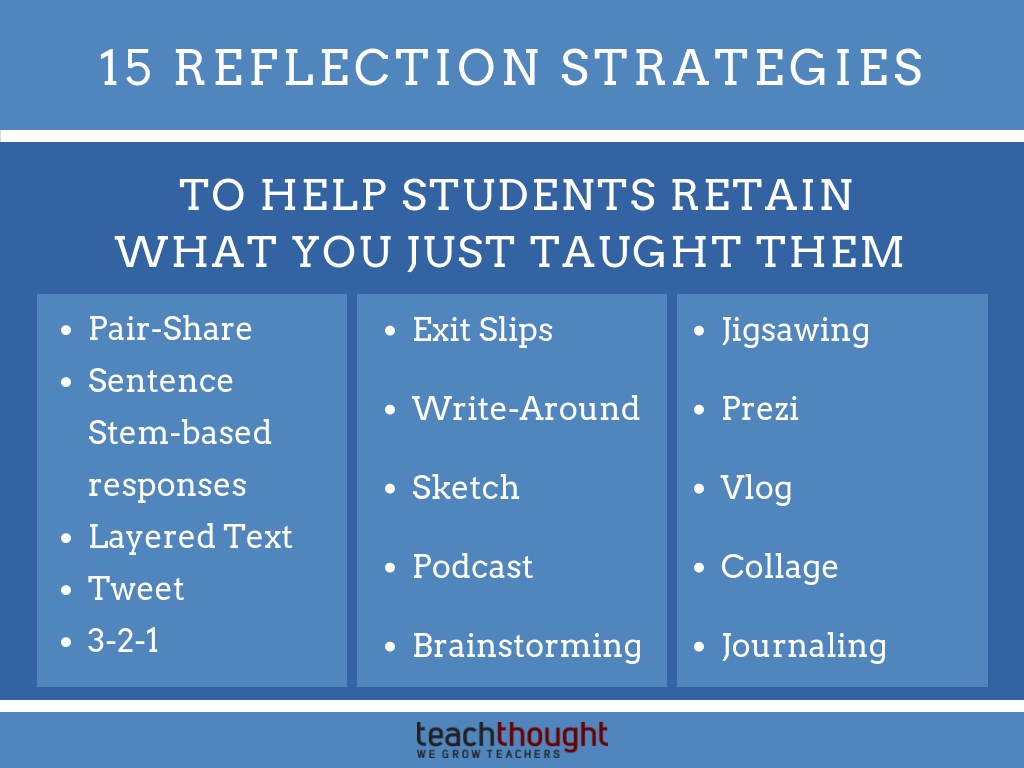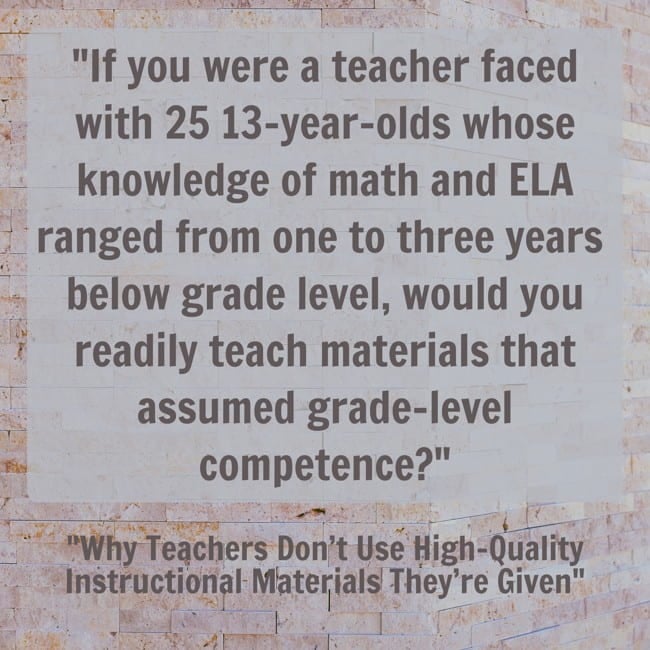15 Reflection Strategies To Help Students Retain What You Just Taught Them
by Terry Heick
Reflection is a natural part of learning.
We all think about new experiences–the camping on the car ride home, the mistakes made in a game, or the emotions felt while finishing a long-term project that’s taken months to complete.
Below I’ve shared 15 strategies for students to reflect on their learning. Modeling the use of each up front can go a long way towards making sure you get the quality of work you’d like to see throughout the year–and students learn more in the process.
15 Reflection Strategies To Help Students Retain What You Just Taught Them
1. Pair-Share
Pair-share is a classic learning strategy where students are paired, and then verbally ‘share’ something that will help them learn new content, deepen understanding, or review what they already know. It can also be used as a quick and dirty assessment tool, as the conversations generally reflect a level of understanding the teacher can use gauge mastery and plan further instruction.
2. Sentence Stem-based responses
Sentence stems are great because they’re like training wheels–or to mix a metaphor, tools to coach students into thinking and speaking in certain patterns. For example, you can implore students to ‘think critically,’ but if they don’t have even the basic phrasing of critical thinking (e.g., ‘This is important because…’), critical thinking will be beyond their reach.
You can also see our sentence stems for critical thinking here for other examples (you don’t have to buy the materials to see the samples).
3. Layered Text
Layered text is something I’ve meant to write about for years and never have. A layered text is a digital document that is filled with hyperlinks that communicate, well, just about anything: Questions students have, opportunities for further inquiry, odd references and allusions that reflect the schema students use to make meaning, and so on. (Rap Genius does a version of this.)
By adding ‘layers’ of meaning to a text through meaningful hyperlinking, students can reflect back on anything, from a pre-assessment journal entry that demonstrated their lack of understanding, to a kind of ‘marking up’ of what they learned when, and from where.
4. Tweet
140 characters forces students to reflect quick and to the point–great for brief bursts of reflection or hesitant writers who would struggle to write meaningful journal entries or essays. In fact, you can combine twitter with #6 for twitter exit slips.
5. 3-2-1
3-2-1 is a tried-and-true way to frame anything from a pair-share or journal entry (e.g., ask students to write 3 things they think they know, 2 things they know they don’t know, and one thing they’re certain of about a topic) pre-assessment to a post-assessment (e.g., list three ways your essay reflected mastery of skill X, two ways skill Y still needs improving, and one way you can make your argument stronger in the next five minutes) to a reflection of the post-assessment.
Read more about using the 3-2-1 format for critical thinking.
6. Exit Slips
Whether you call them exit slips or exit tickets, asking students to briefly leave behind some residue of learning–a thought, a definition, a question–is a powerful teaching strategy. In fact, ‘exit-slip teaching’ literally drives how I use data in the classroom. Asking students to drop some bit of reflection of the learning process on a chair by the door on the way out is a no-brainer.
Some examples?
How did you respond emotionally to something you struggled with today? What did you find most surprising about _____? How did your understanding of _______ change today? What about _____ still confuses you or makes your curious?
7. Write-Around
I love write-arounds–easy ways for students to write asynchronously and collaboratively. And the writing fragments students use don’t have to be prose–certain key vocabulary and phrases can help students reflect, but most importantly in a write-around, help students learning from one another as each student is able to read other responses before creating theirs.
8. Sketch
Whether by sketch-notes or doodles, allowing students to draw what they think they know, how they believe their learning has changed, or some kind of metaphorical pathway towards deeper understanding is a great learning strategy for students that tend towards creative expression, and a non-threatening way for struggling students to at least write something down on paper you can use to gauge understand and plan your (their) next step.
9. Podcast
Through podcasting as a reflecting strategy, students will talk about their learning while recording. If you want to keep it ‘closed-circuit’ (not published), or actually push it to a public audience of some kind depends on the learning and students and privacy issues and so on.
This can also be simply an audio file recorded and uploaded to a private YouTube channel that’s shared with teachers or parents.
10. Brainstorming
Brainstorming can be an effective reflection strategy because it disarms issues with other approaches. For hesitant writers, journaling may not work because the writing process could overwhelm the learning. Podcasting may not work for shy students, Pair-Share may not work well if students are paired effectively, and so on.
Brainstorming is much simpler. Students could take an allotted time to write down everything they remember about a topic. Or, they could brainstorm questions they still have (things they’re confused or curious about). They could even brainstorm how what what they learned literally connects with what they already know by creating a concept map.
11. Jigsawing
Jigsawing is a grouping strategy where a task, concept, or something ‘larger’ is broken down into small puzzles pieces, and students in groups analyze the small puzzle piece, then share out to create the puzzle at large. Using this approach for reflection is seamless: Among other approaches, you can prompt students in groups to gather and share questions they have (you could group by readiness/ability, for example) in groups, and then choose one question that they weren’t able to answer among themselves with the whole class (anonymously–no one has to know who wrote the question).
12. Prezi
Think of a cross between a sketch, collage, and presentation, and you have a prezi. Engaging–though distracting and overwhelming if the reflection you need is minor–reflection tool that allows students to create an artifact of learning for their digital portfolios.
13. Vlog
This reflection strategy is close to ‘Podcasting’ and even has something in common with pair-sharing. By reflecting through vlog’ing, students simply talk about their learning to a camera.
This approach would be successful for students that love talking to a camera, but less so for others (who, if they have to talk at all about their learning, may prefer podcasting–or simply recording audio files that are never published.
14. Collage
You could do a normal collage of learning reflections, but a multimedia collage is also possible–maybe a sketchnote with a voiceover recorded as a YouTube video to share as a quick presentation with the class (or absent students).
15. Journaling
The University of Missouri-St Louis offers 3 kinds of journals that demonstrate the different possibilities of the otherwise vanilla-sounding ‘journaling.’
1. Personal Journal – Students will write freely about their experience. This is usually done weekly. These personal journals may be submitted periodically to the instructor, or kept as a reference to use at the end of the experience when putting together an academic essay reflecting their experience. (Hatcher 1996)
2. Dialogue Journal – Students submit loose-leaf pages from a dialogue journal bi-weekly (or otherwise at appropriate intervals) for the instructor to read and comment on. While labor intensive for the instructor, this can provide continual feedback to students and prompt new questions for students to consider during the semester. (Goldsmith, 1995)
3. Highlighted Journal – Before students submit the reflective journal, they reread personal entries and, using a highlighter, mark sections of the journal that directly relate to concepts discussed in the text or in class. This makes it easier for the instructor to identify the student to reflect on their experience in light of course content. (Gary Hesser, Augsberg College)
15 Strategies For Students To Reflect On Their Learning; image attribution Flickr user woodleywonderworks
The post Strategies To Help Students Retain What You Taught Them appeared first on TeachThought.
By asking students to leave a little learning on a chair by the door on the way out of the classoom, exit slips are an easy way to reflect on learning.
The post Strategies To Help Students Retain What You Taught Them appeared first on TeachThought. Learning, Essential, Parents, Strategies TeachThought








